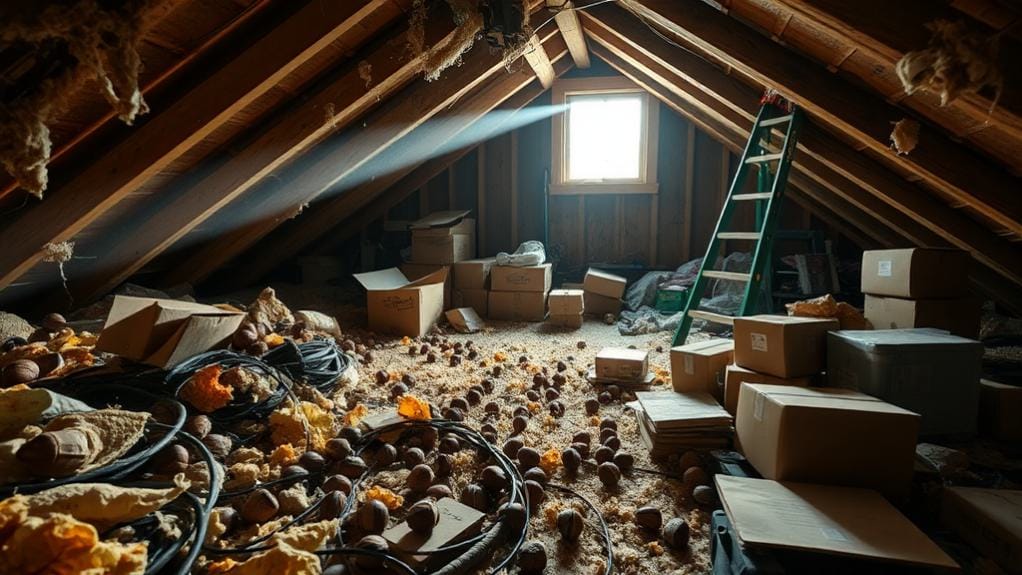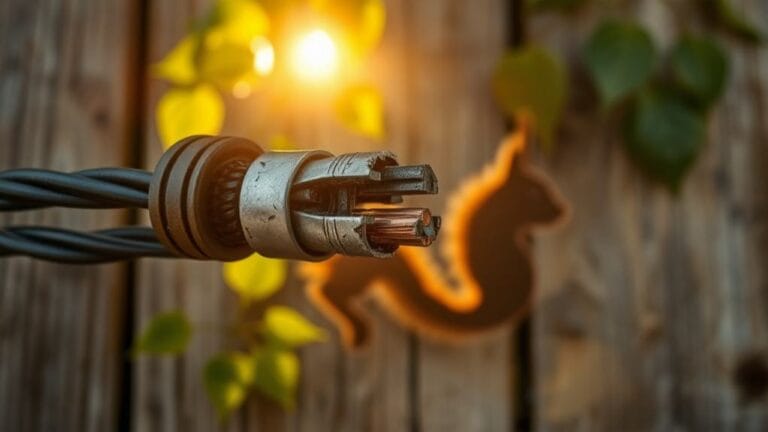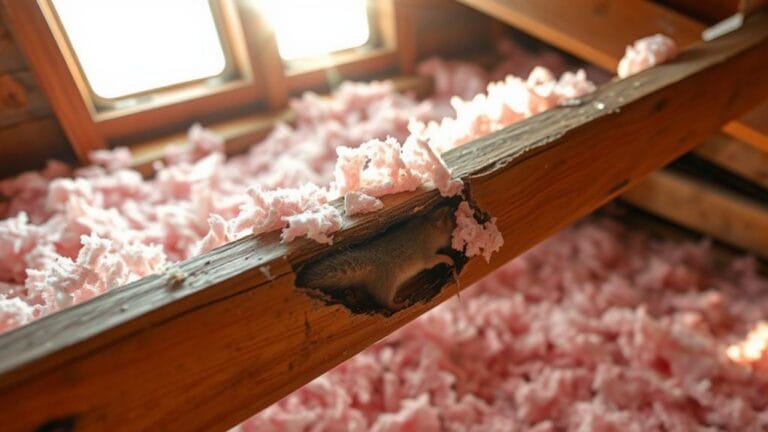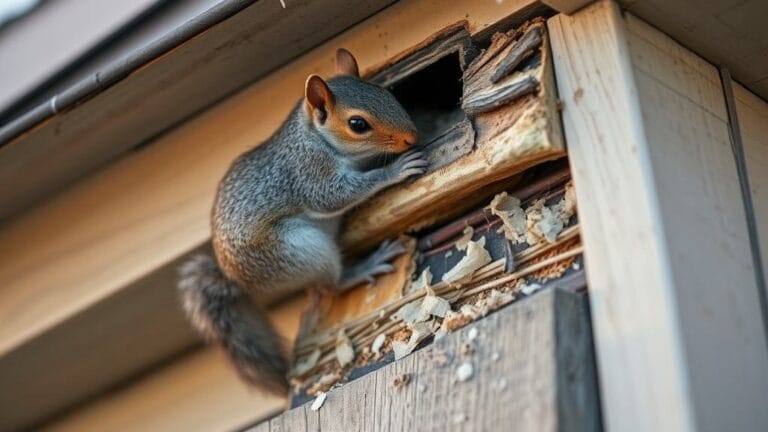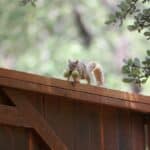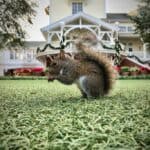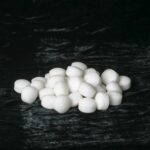Time to tackle that squirrel-infested attic mess – but don't just grab a broom and go charging up there! You'll need proper safety gear first: thick rubber gloves, face mask, and protective eyewear. Start by documenting all damage and entry points with photos (your insurance company will thank you). Remove every bit of contaminated material, especially that nasty insulation they've turned into their personal playground. Hit everything with enzyme cleaners to kill germs and odors. Replace insulation, seal entry points, and set up prevention measures. Trust us – there's way more to this cleanup than just sweeping up nuts and acorns.
Identifying Signs of Squirrel Damage
Table of Contents
Throughout your attic space, squirrel damage leaves distinct calling cards that help pinpoint the extent of an infestation. While lethal trap options exist for removal, prevention starts with spotting the signs early.
You'll know these unwanted guests have moved in when you spot their signature squirrel poop – those lovely little brown pellets with rounded ends scattered around like unwanted house-warming gifts.
Listen up, because these fuzzy invaders aren't subtle:
- That scratching sound at night? Yep, they're redecorating your attic.
- Shredded insulation means they're building their dream nest with YOUR materials.
- Mysterious holes in walls or vents? Congratulations – you've got squirrel doorways.
- That funky smell? It's not your imagination. Their droppings and urine are creating a toxic paradise.
*Pro Tip: Start cleaning up the mess ASAP. The longer you wait, the more these bushy-tailed contractors will renovate without your permission.*
Safety Equipment and Precautions
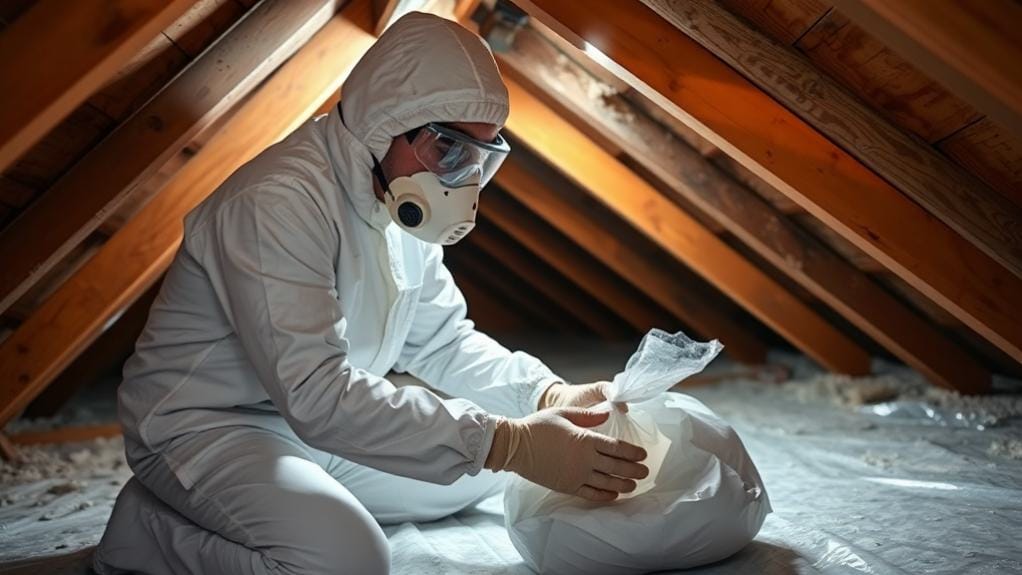
Three essential pieces of protective gear stand between you and serious health risks when tackling squirrel cleanup duty.
You'll need thick rubber gloves, a proper face mask, and protective eyewear – and no, your regular reading glasses won't cut it! For ideal hand protection, double-layered construction gloves with reinforced palms provide the best defense against potential bites or scratches.
Don't even think about skipping the safety gear unless you're a fan of potential respiratory issues and nasty infections. Your health isn't worth the shortcut.
Pro Tips for Maximum Protection:
- Wear a qualified respirator if you're dealing with strong odors – your dollar store dust mask won't help here.
- Keep those windows open while cleaning – unless you enjoy getting dizzy from cleaning fumes.
- Never play chemist by mixing different cleaners – unless a trip to the ER is on your bucket list.
Remember: Proper ventilation is your best friend during this not-so-fun squirrel aftermath cleanup mission.
Initial Assessment and Documentation
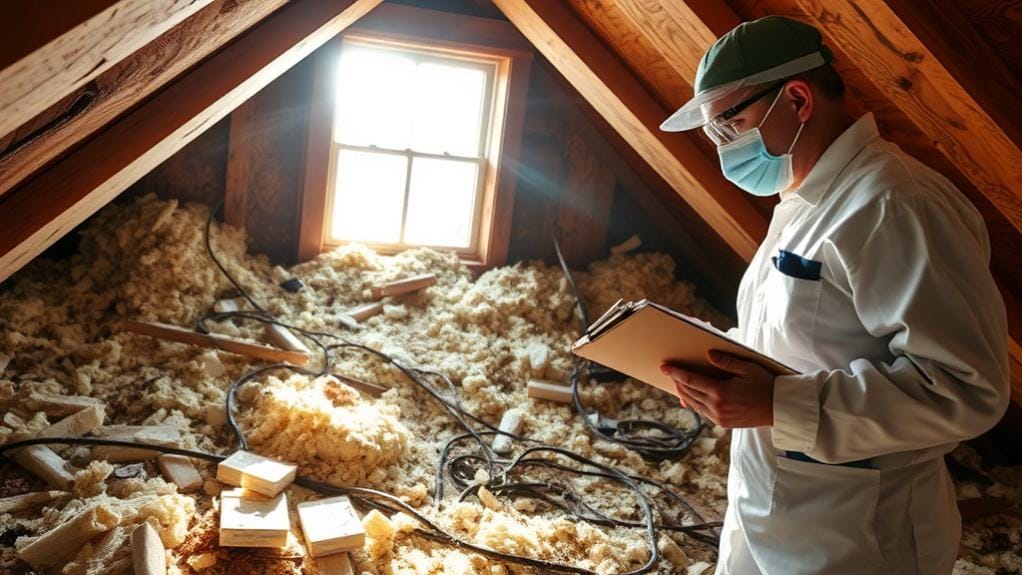
A proper attic cleanup starts with mapping out your battlefield. Before you plunge into wildlife removal, you'll need to play detective and document every nasty detail of your unwanted squirrel tenants' activities.
Trust me – it's not the most glamorous job, but it's vital. Understanding structural and electrical hazards is essential since squirrels can chew through wiring and create fire risks.
Grab your camera and get ready to:
- Search every corner for droppings (yes, all of them)
- Identify and photograph entry points where those furry invaders got in
- Check your insulation for damage – because squirrels love turning it into their personal bed and breakfast
- Mark areas that'll need Insulation Removal (and there's probably more than you think)
*Pro Tip: Take way more photos than you think you need. They'll help prove the damage to your insurance company, and you'll want "before" shots to compare with your cleanup results.*
Removal of Contaminated Materials
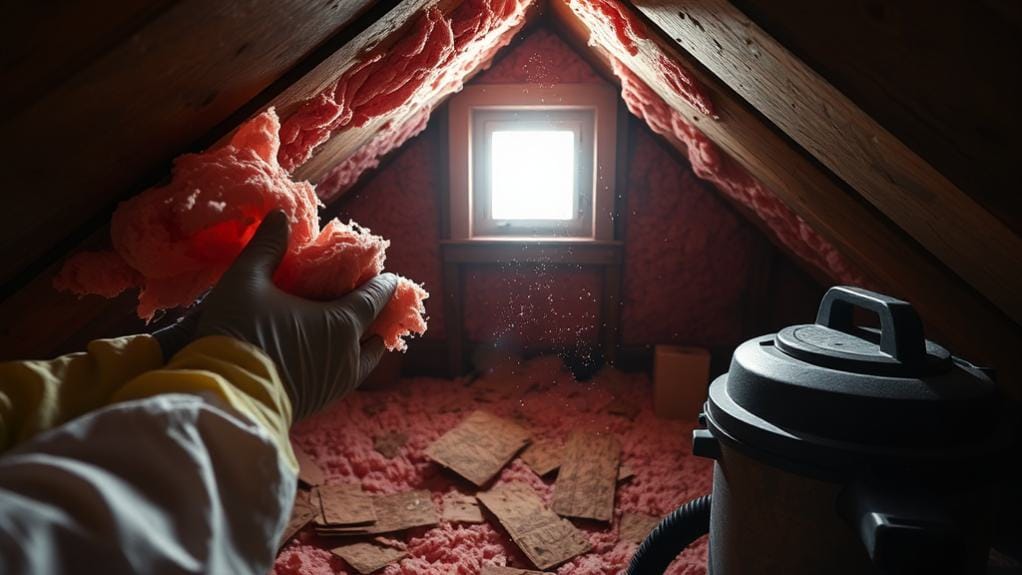
Your attic's contaminated materials pose serious health risks that demand immediate attention. Identifying nesting material piles and droppings is essential for thorough removal.
Before you even think about tackling those squirrel droppings, suit up properly – unless you fancy a trip to the ER. You'll need gloves and a mask. No shortcuts here, folks.
Here's your battle plan:
- Use a filter vacuum to collect droppings (trust me, you don't want to sweep these nasties)
- Remove contaminated insulation completely – don't try to be a hero and save it
- Sanitize the entire area with enzyme-based cleaners
Pro tip: If you're wondering whether to keep or toss soiled materials, just toss them. Better safe than sorry!
Remember: Those cute little squirrels left behind some not-so-cute pathogens. When in doubt, incinerate contaminated materials. Your lungs will thank you later.
Sanitization and Odor Treatment
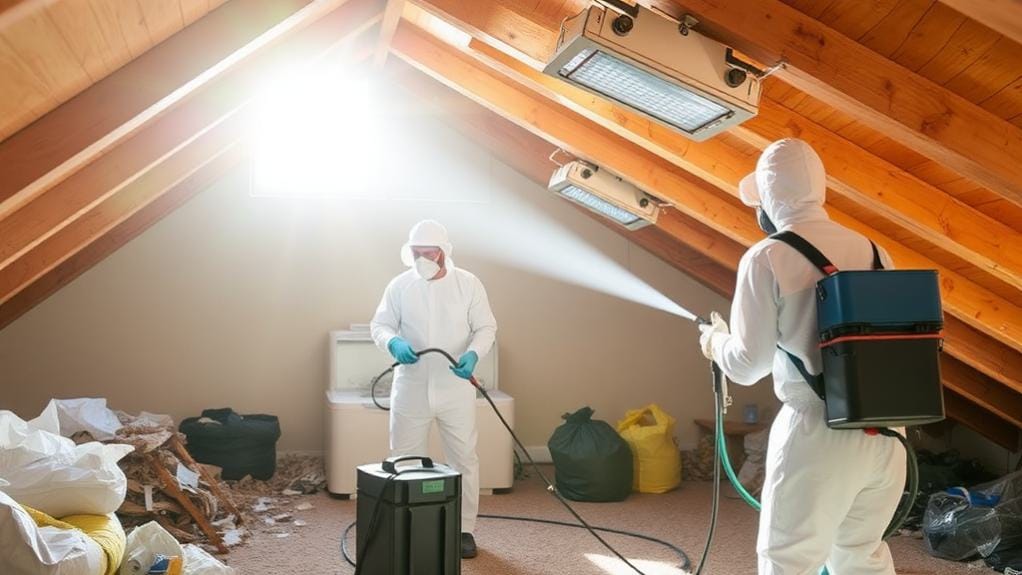
Once you've removed all contaminated materials, proper sanitization becomes critical for eliminating harmful bacteria and lingering odors.
After squirrel removal, you'll need to get serious about disinfection – because nobody wants their attic smelling like a rodent resort. Understanding natural squirrel behavior helps identify areas needing extra attention during cleanup, especially where nesting occurred.
Start with these essential steps:
- Apply enzyme-based cleaners to all affected surfaces
- Use a fogging machine for those hard-to-reach spaces
- Scrub areas with warm, soapy water to eliminate pheromones
- Don't forget to disinfect or dispose of your cleaning supplies
Pro Tip: Those lingering odors aren't just unpleasant – they're basically a "Welcome Home" sign for other squirrels.
Keep checking your attic regularly after cleanup. If you catch even a hint of that familiar funk, you'll want to repeat the sanitization process.
Trust me, being thorough now beats dealing with Squirrel Family Reunion 2.0 later.
Insulation Replacement and Repairs
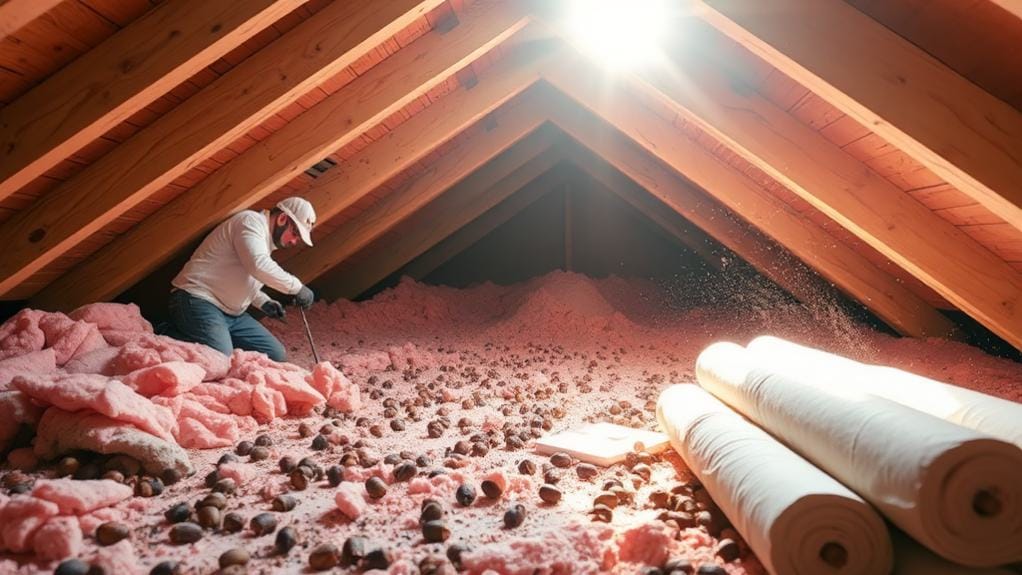
Professional insulation replacement marks the vital final phase of squirrel damage restoration.
Let's face it – those pesky critters didn't exactly leave your attic in pristine condition. During Attic Pest Clean-up, you'll need to strip out every bit of contaminated insulation. No shortcuts here!
Your next steps are essential:
- Remove all old insulation (yes, ALL of it)
- Install fire-retardant blankets around hot flues (unless you're into household fires)
- Add baffles to your soffits for proper ventilation
- Install new cellulose insulation to R-40 or R-50 levels
Pro Tip: Don't cheap out on insulation replacement. Proper R-values aren't just fancy numbers – they're your ticket to lower energy bills and a squirrel-proof barrier.
Remember: Half-measures now mean double the work later. Confirm thorough sanitization before laying new insulation.
Sealing Entry Points
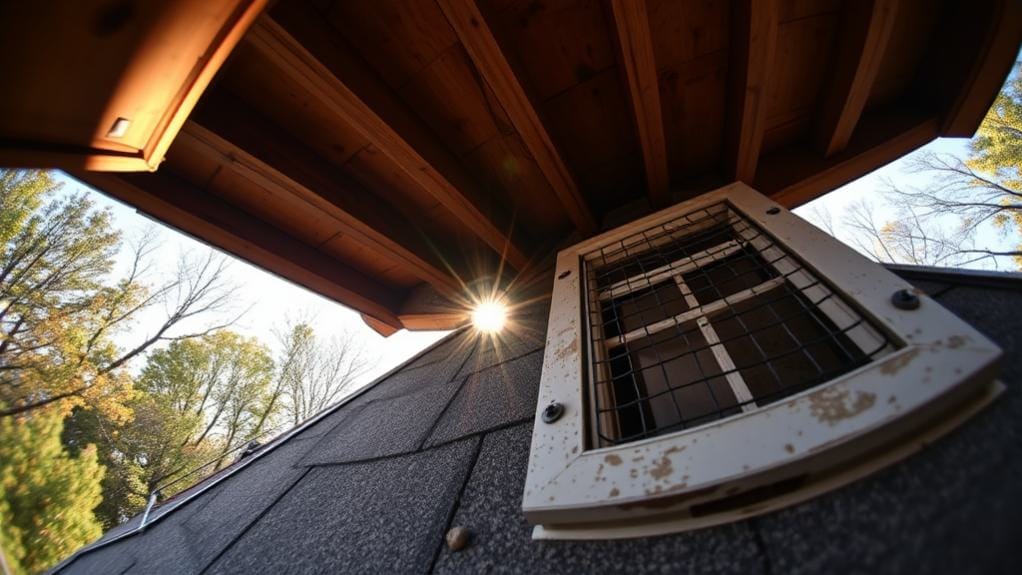
Securing every potential entry point into and around your attic stands as the most critical step in preventing future squirrel invasions.
You'd be shocked how these bushy-tailed acrobats can squeeze through holes barely bigger than a golf ball – we're talking just 1.5 inches!
Don't let their cute faces fool you.
Here's what you need to check (and yes, all of them):
- Vents and chimneys (their favorite VIP entrance)
- Gaps around utility lines
- Damaged soffits
- Any suspicious-looking holes
Pro tip: Skip the DIY guesswork and get a wildlife control company to do a thorough inspection. They'll spot sneaky entry points you might miss.
Use heavy-duty materials for sealing entry points:
- Steel mesh
- Hardware cloth
- Quality foam sealant
Remember: A half-done job is basically rolling out the red carpet for Round 2.
Preventive Measures Moving Forward
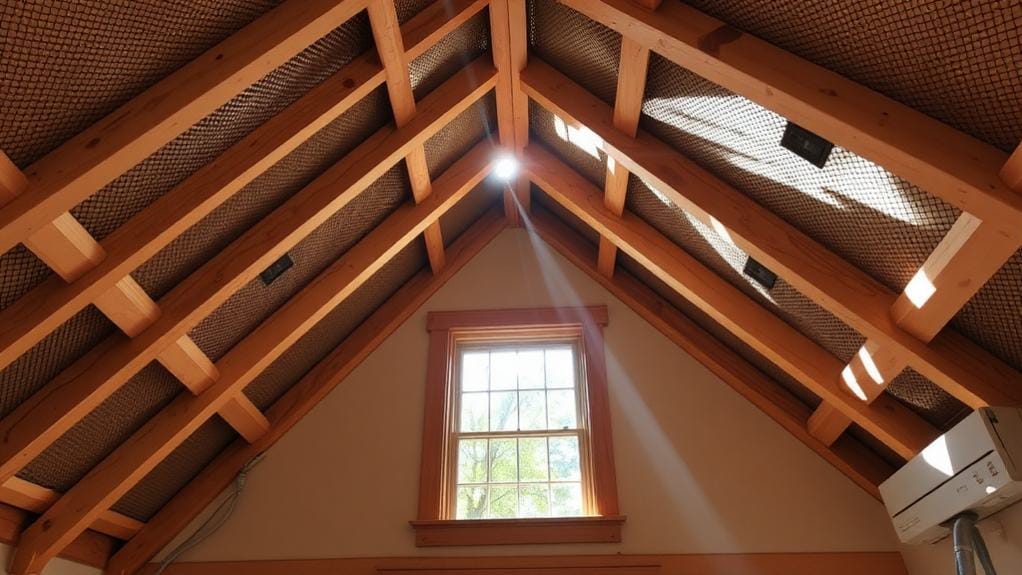
The key to keeping squirrels from turning your attic into their personal Airbnb lies in consistent prevention. You'll need to stay on top of preventive measures if you want to maintain your attic's energy efficiency and keep those furry freeloaders out for good.
| Task | Frequency | Importance |
|---|---|---|
| Attic Inspection | Monthly | Critical |
| Entry Point Check | Quarterly | High |
| Bird Feeder Maintenance | Weekly | Medium |
| Exterior Tree Trimming | Bi-annually | High |
| Professional Assessment | Yearly | Essential |
*Pro Tip: Your attic isn't a squirrel hotel – don't give them amenities!*
Get serious about these preventive measures:
- Schedule regular inspections (because surprise squirrel parties aren't fun)
- Remove tempting nesting materials
- Install motion-sensor lights
- Keep tree branches trimmed at least 8 feet from your roof
Remember: An ounce of prevention beats a pound of squirrel drama any day!
Frequently Asked Questions
How Do You Clean up an Attic After Squirrels?
You'll need to wear protective gear, remove droppings with a vacuum, sanitize surfaces with enzyme cleaners, replace contaminated insulation, and seal entry points to prevent future infestations in your attic.
How Do You Clean an Attic After a Rodent Infestation?
Like clearing shadows from your sanctuary, you'll need to vacuum droppings with a HEPA filter, sanitize surfaces, replace contaminated insulation, and seal entry points—all while wearing protective gear for safety.
How to Decontaminate an Attic?
You'll need to wear protective gear, remove all droppings and nests with a filtered vacuum, sanitize surfaces with enzyme cleaners, replace soiled insulation, and seal entry points to prevent future contamination.
How Long Will Squirrels Stay in Attic?
Like uninvited houseguests, squirrels can stay in your attic from a few weeks to several months. You'll notice them most during spring nesting season, and they'll stick around longer if they're raising babies.
Last Word
You've faced down the squirrel squad and won! Like a home-owning superhero, you've cleared the damage, sanitized the chaos, and fortified your attic against future invasions. Let's be honest – it wasn't fun crawling around in squirrel souvenirs, but you've transformed your attic from a rodent resort back into secure storage space. Stay vigilant with regular inspections and maintenance, because those bushy-tailed bandits are always plotting their comeback.

